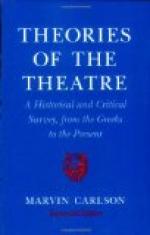Wit’s now arrived to a more high degree;
Our native language more refined and free:
Our ladies and our men now speak more wit
In conversation than those poets writ.
This criticism was characteristic of a new era that was dawning in the English drama, during which a playwright could hope for no greater glory than to be praised for the brilliancy of his dialogue or the smartness of his repartee.
At the present day, if you ask the average theatre-goer about the merits of the play that he has lately witnessed, he will praise it not for its stately speeches nor its clever repartee, but because its presentation was “so natural.” He will tell you that A Woman’s Way gave an apt and admirable reproduction of contemporary manners in New York; he will mention the make of the automobile that went chug-chugging off the stage at the second curtain-fall of Man and Superman, or he will assure you that Lincoln made him feel the very presence of the martyred President his father actually saw.
These different classes of comments give evidence of three distinct steps in the evolution of the English drama. During the sixteenth and seventeenth centuries it was essentially a Drama of Rhetoric; throughout the eighteenth century it was mainly a Drama of Conversation; and during the nineteenth century it has grown to be a Drama of Illusion. During the first period it aimed at poetic power, during the second at brilliancy of dialogue, and during the third at naturalness of representment. Throughout the last three centuries, the gradual perfecting of the physical conditions of the theatre has made possible the Drama of Illusion; the conventions of the actor’s art have undergone a similar progression; and at the same time the change in the taste of the theatre-going public has made a well-sustained illusion a condition precedent to success upon the modern stage.
II
Mr. Ben Greet, in his sceneless performances of Shakespeare during recent seasons, has reminded us of some of the main physical features of the Elizabethan theatre; and the others are so generally known that we need review them only briefly. A typical Elizabethan play-house, like the Globe or the Blackfriars, stood roofless in the air. The stage was a projecting platform surrounded on three sides by the groundlings who had paid threepence for the privilege of standing in the pit; and around this pit, or yard, were built boxes for the city madams and the gentlemen of means. Often the side edges of the stage itself were lined with young gallants perched on three-legged stools, who twitted the actors when they pleased or disturbed the play by boisterous interruptions. At the back of the platform was hung an arras through which the players entered, and which could be drawn aside to discover a set piece of stage furnishing, like a bed or a banqueting board. Above the arras was built




